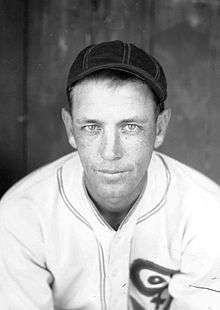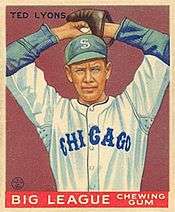Ted Lyons
Theodore Amar Lyons (December 28, 1900 – July 25, 1986) was an American professional baseball starting pitcher, manager and coach in Major League Baseball (MLB). He played in 21 MLB seasons, all with the Chicago White Sox. He is the franchise leader in wins.[1] Lyons won 20 or more games three times (in 1925, 1927, and 1930) and became a fan favorite in Chicago.
| Ted Lyons | |||
|---|---|---|---|
 Lyons in 1930 with the Chicago White Sox. | |||
| Pitcher / Manager | |||
| Born: December 28, 1900 Lake Charles, Louisiana | |||
| Died: July 25, 1986 (aged 85) Sulphur, Louisiana | |||
| |||
| MLB debut | |||
| July 2, 1923, for the Chicago White Sox | |||
| Last MLB appearance | |||
| May 19, 1946, for the Chicago White Sox | |||
| MLB statistics | |||
| Win–loss record | 260–230 | ||
| Earned run average | 3.67 | ||
| Strikeouts | 1,073 | ||
| Managerial record | 185–245 | ||
| Winning % | .430 | ||
| Teams | |||
| As player
As manager | |||
| Career highlights and awards | |||
| |||
| Member of the National | |||
| Induction | 1955 | ||
| Vote | 86.5% (eighth ballot) | ||
He was inducted into the Baseball Hall of Fame in 1955. He has the third-highest career ERA of any Hall of Fame pitcher.[2] He is also the only Hall of Fame pitcher to have more walks than strikeouts.
Career
Playing career

Lyons broke into the major leagues in 1923 after playing collegiate baseball at Baylor University. He joined the White Sox on a road trip and never pitched a day in the minors. Lyons recorded his first two wins as a relief pitcher in a doubleheader on October 6, 1923, making him one of the first pitchers to perform the feat. He worked his way into the starting rotation the following year, when he posted a 12–11 record and 4.87 ERA.
On August 21, 1926, Lyons no-hit the Boston Red Sox 6–0 at Fenway Park; the game took just 1 hour and 45 minutes to complete (Ted Lyons August 21, 1926 No-hitter Box Score).
Lyons was at his crafty best in 1930, when he posted a 22–15 record and A.L.-leading totals of 29 complete games and 297⅔ innings for a team that finished 62–92. Prior to a 1931 arm injury, his pitches included a "sailer" (now known as a cut fastball), knuckleball, curveball, and changeup. After the 1931 injury, his pitches included a fastball, slow curve, knuckleball and an even slower curveball used as a changeup.[3]
As Lyons aged, his career benefited from the White Sox' decision to never let him pitch more than 30 games per season from 1934 on. He was such a draw among the fans that, as his career began to wind down in 1939, manager Jimmy Dykes began using him only in Sunday afternoon games,[4] which earned him the nickname "Sunday Teddy". Lyons made the most of his unusual scheduling, winning 52 of 82 decisions from 1939 until 1942.
During 1942, Lyons' 20th and last full season, he led the league with a 2.10 ERA and completed every one of his 20 starts. Although exempt from the military draft due to age, after the season he enlisted in the United States Marine Corps and fought in the Pacific War. In 1943, the White Sox announced that Lyons' jersey number would not be reissued.[5] In May of that year, he was based in Chicago at the Navy Pier. He commented that he would not be able to return to pitching if the war lasted three or four more years.[6]
Lyons made a brief return to the mound in 1946, with a 2.32 ERA[4] in five games, all complete. He stopped pitching for good that season, having compiled a 260–230 record, 356 complete games, 1073 strikeouts and a 3.67 ERA. Lyons never appeared in a postseason game, as the generally mediocre-to-poor White Sox were usually far behind the American League leaders during his career. In Lyons' 21 seasons with the Sox, they finished fifth or lower (in an eight-team league) 16 times, and never finished higher than third. New York Yankees manager Joe McCarthy said, "If (Lyons had) pitched for the Yankees, he would have won over 400 games."
Lyons was a better than average hitting pitcher in his 21-year major league career, posting a .233 batting average (364-for-1563) with 162 runs, 49 doubles, 9 triples, 5 home runs, 149 RBI and 73 bases on balls. He was used as a pinch hitter 45 times. Defensively, he recorded a .958 fielding percentage which was only a couple of points higher than the league average at his position.
Managing and coaching career
Lyons succeeded Dykes as the White Sox manager in May 1946 after an apparent contract dispute between Dykes and Grace Comiskey.[7] He had less success as a manager than he had as a player, guiding them to a meager 185–245 record. Lyons resigned as manager in October 1948.[8]
Lyons coached the pitchers for the Detroit Tigers (1949–52) and Brooklyn Dodgers (1954).

Later life
In 1955, he was inducted into the Baseball Hall of Fame. Lyons served as a scout with the White Sox until his retirement in 1967.[9] Lawrence Ritter and Donald Honig included Lyons in their book The 100 Greatest Baseball Players of All Time (1981).
On July 25, 1986, Lyons died in a nursing home in Sulphur, Louisiana.[10] One year later, the Chicago White Sox retired his uniform number, #16.
See also
- List of knuckleball pitchers
- List of Major League Baseball career wins leaders
- List of Major League Baseball annual ERA leaders
- List of Major League Baseball annual wins leaders
- List of Major League Baseball no-hitters
- List of Major League Baseball player-managers
- List of Major League Baseball players who spent their entire career with one franchise
References
- "Chicago White Sox Top 10 Pitching Leaders". Baseball Reference. Retrieved 14 January 2011.
- Hall of Fame Pitchers list
- The Neyer/James Guide to Pitchers: An Historical Compendium of Pitching, Pitchers, and Pitches. Bill James and Rob Neyer. 2004.
- Bullock, Steven R. (2004). Playing for Their Nation: Baseball and the American Military during World War II. University of Nebraska Press. pp. 110–111, 135–136. ISBN 0-8032-1337-9.
- "Lyons' jersey retired". Milwaukee Journal. April 22, 1943. Retrieved December 5, 2014.
- Hoff, Dave (May 8, 1943). "Lyons plans return to mound after war". St. Petersburg Times. Retrieved December 5, 2014.
- "Pitcher Ted Lyons new Chicago skipper". Montreal Gazette. May 25, 1946. Retrieved December 5, 2014.
- "O'Connor said to have left Chicago Sox". Daytona Beach Morning Journal. October 6, 1948. Retrieved December 5, 2014.
- "Chicago writers to honor Ted Lyons". Reading Eagle. January 5, 1968. Retrieved December 5, 2014.
- "Hall of Famer, Ted Lyons". Bangor Daily News. July 25, 1986. Retrieved December 5, 2014.
Further reading
- Honig, Donald (1975) Baseball When the Grass Was Real: Baseball from the Twenties to the Forties Told by the Men Who Played It. New York: Coward, McGann & Geoghegan. pp. 108–125. SBN 698-10660-1.
External links
- Ted Lyons at the Baseball Hall of Fame
- Career statistics and player information from MLB, or ESPN, or Baseball-Reference, or Fangraphs, or Baseball-Reference (Minors)
- Ted Lyons managerial career statistics at Baseball-Reference.com
- Ted Lyons at Find a Grave
| Preceded by Howard Ehmke |
No-hitter pitcher August 21, 1926 |
Succeeded by Carl Hubbell |